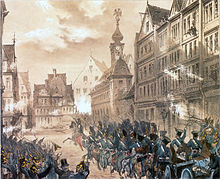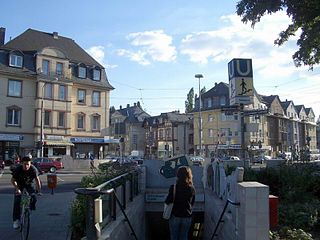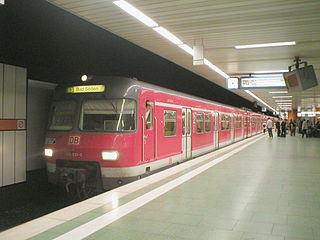

Konstablerwache is a square in the centre of Frankfurt am Main and part of the city's pedestrian zone. It lies to the east of Hauptwache with both squares linked by the Zeil, the central shopping street of the city.


Konstablerwache is a square in the centre of Frankfurt am Main and part of the city's pedestrian zone. It lies to the east of Hauptwache with both squares linked by the Zeil, the central shopping street of the city.
At the corner of the current Konstablerwache square near the street of Fahrgasse, an armoury was established in 1544 for the defence of Frankfurt; this long represented the eastern end of the Zeil. In 1822 the building, which had been upgraded into a military guard house, was converted into a police station. The name Konstablerwache, (literally: "constable watch-house") comes from the period when the building was used as an armoury; the term constable was then used in Frankfurt for a military rank in the artillery. In 1833, it was at the centre of an attempted revolution when revolutionary students attacked and attempted to loot it and the main watch-house (Hauptwache).

Later the two watch-houses proved too small for a growing city, and a new police headquarters was built at Hohenzollernplatz (now Platz der Republik). In contrast to Hauptwache, Konstablerwache was demolished in 1886 and replaced by commercial buildings. The Bienenkorbhaus office building was built on the site in 1953–54, the architect was Johannes Krahn.
Until 1881 the present square was a significant but narrow road junction at the end of the broad street of the Zeil, with Allerheiligenstraße connecting towards the southeast to Allerheiligentor, Fahrgasse continuing to the east and Große Friedberger Strasse as the main north-south link in the old town, leading to Alte Brücke (old bridge) in the south and Friedberger Tor in the north. In that year, the New Zeil was built as a wide commercial street leading from Konstablerwache to the east towards Friedberger Anlage (the eastern section of the old city wall). Between the New Zeil and Allerheiligenstraße there was a small square, which was far smaller than the modern square. At the beginning of the 20th century Konstablerwache became a major transport hub, both for cars and trams.
The situation changed dramatically after the Second World War. With many of the buildings on the Zeil destroyed in air raids, it was decided not to rebuild all of them in order to create a larger square. At the same time Kurt-Schumacher-Strasse was built, replacing Fahrgasse as the main north-south route in the eastern part of the city, and giving Konstablerwache its current eastern boundary. When the square was converted into a pedestrian zone, the level of the square was raised by just under 80 centimetres in order to create room for the underground U-Bahn/S-Bahn station.

The former tram junction lost its significance when the main tram lines were closed in the inner city in the 70s. The Zeil was initially served by trams even after its conversion into a pedestrian zone; the track was closed during the construction of the S-Bahn tunnel between Hauptwache and Konstablerwache, a new line was built in the parallel Stephanstraße, taking over part of the traffic. This line had been closed in the 1960s, but was put back into operation until 1986 as the terminus of line 12 connecting to Nordend. In 1999, tram tracks were opened in Kurt-Schumacher-Straße, creating a through route for line 12 from Fechenheim to Schwanheim.
Konstablerwache station, situated under the square, is a major interchange on Frankfurt's U-Bahn and S-Bahn networks.

Frankfurt am Main is the most populous city in the German state of Hesse. Its 773,068 inhabitants as of 2022 make it the fifth-most populous city in Germany. Located in the foreland of the Taunus on its namesake Main, it forms a continuous conurbation with Offenbach am Main; its urban area has a population of over 2.7 million. The city is the heart of the larger Rhine-Main metropolitan region, which has a population of more than 5.8 million and is Germany's second-largest metropolitan region after the Rhine-Ruhr region and the fourth biggest metropolitan region by GDP in the European Union. Frankfurt is home to the European Central Bank, one of the institutional seats of the European Union, while Frankfurt's central business district lies about 90 km (56 mi) northwest of the geographic center of the EU at Gadheim in Lower Franconia. Like France and Franconia, the city is named after the Franks. Frankfurt is the largest city in the Rhenish Franconian dialect area.

The Altstadt is a quarter of Frankfurt am Main, Germany. It is part of the Ortsbezirk Innenstadt I and is located on the northern Main river bank. It is completely surrounded by the Innenstadt district, Frankfurt's present-day city centre. On the opposite side of the Main is the district of Sachsenhausen.

The Hauptwache is a central point of Frankfurt am Main and is one of the most famous plazas in the city. The original name Schillerplatz was superseded in the early 1900s. It lies to the west of Konstablerwache with both squares linked by the Zeil, the central shopping area of the city.

The Innenstadt is the central city district of Frankfurt am Main, Germany. It is part of the Ortsbezirk Innenstadt I. Its western part forms part of Frankfurt's central business district, the Bankenviertel. Germany's most expensive shopping streets and real estate are found within the city district.

Dornbusch is a quarter of Frankfurt am Main in Hesse, Germany. It is located north of the city center and north of the River Main, and is part of the Ortsbezirk Mitte-Nord. Dornbusch is clockwise surrounded by Eschersheim, Eckenheim, Nordend-West, Westend-Nord, Bockenheim, and Ginnheim.

The Zeil is a street in the city centre of Frankfurt, Germany. The name, which dates back to the 14th century, is derived from the German word Zeile "row" and originally referred to a row of houses on the eastern end of the north side; the name was not extended to the entire street until later.

The Rhine-Main S-Bahn system is an integrated rapid transit and commuter train system for the Frankfurt/Rhine-Main region, which includes the cities Frankfurt am Main, Wiesbaden, Mainz, Offenbach am Main, Hanau and Darmstadt. The network comprises nine S-Bahn lines, eight of which currently travel through the cornerstone of the system, a tunnel through central Frankfurt. The first section of this tunnel was opened on May 28, 1978. Further tunnel sections were opened in 1983 and 1990, before its completion in 1992. The system belongs to the Rhein-Main-Verkehrsverbund (RMV) and is operated by DB Regio, a subsidiary of Deutsche Bahn.
The B Line is the second line in the network of the Frankfurt U-Bahn, running in a west–east direction from the central railway station (Hauptbahnhof) through the old town to Konstablerwache, where it splits into two branches to Bornheim and Preungesheim. Originally planned as an independent main line, part of the D Line forms an extension of U4 to Bockenheimer Warte from the central railway station.

Frankfurt (Main) Süd or Frankfurt Südbahnhof is one of three railway stations for long-distance train services in Frankfurt, Germany. Unlike Frankfurt Hauptbahnhof it is not a terminus but a through station, and has nine tracks with five platforms. It is a stopping station for some long-distance routes and for regional traffic. It is also one of the major rapid-transit railway hubs in the city with S-Bahn and U-Bahn services.

Bankenviertel is the name of the central business district in Frankfurt, Germany where many banks, insurance companies, and other financial institutions are located. It is the most important German financial hub, if not one of the largest in Europe along with La Défense in the Paris aire urbaine and London's City and Canary Wharf.

The Frankfurt am Main tramway network is a network of tramways forming a major part of the public transport system in Frankfurt am Main, a city in the federal state of Hesse, Germany.

The Frankfurt City Tunnel is a standard gauge railway in Frankfurt and the core of the Rhine-Main S-Bahn. The line runs underground for its entire length.

Frankfurt (Main) Hauptbahnhof is a four-track S-Bahn station below Frankfurt (Main) Hauptbahnhof and as such part of the busiest railway station in Frankfurt, Germany. It is also the busiest rapid transit station in Frankfurt.

Frankfurt (Main) Hauptwache station is a major train station situated at the Hauptwache square in the centre of Frankfurt, Germany.

Frankfurt am Main Konstablerwache station is a major train station and metro station at the Konstablerwache square in the city centre of Frankfurt am Main, Germany.

The A line is the north-to-south main line of the Frankfurt U-Bahn. It is the oldest and longest line of the U-Bahn system. Served by four routes starting at Südbahnhof Railway Station in Sachsenhausen, the A line runs through downtown Frankfurt up to Heddernheim Station in the north of the city, where it branches out to Ginnheim, Oberursel (U3), Riedberg and Bad Homburg (U2). The U9 service between Ginnheim, Riedberg and Nieder-Eschbach does not use the central section and tunnels of the line, making it the only light rail service of the network that does not serve downtown Frankfurt. The Riedberg and Ginnheim branches were planned as parts of the future D line subway but are operationally part of the A line until the D line development and construction is finished.

The Line C is a line on the Frankfurt U-Bahn. It consists of the U6 and the U7.

Frankfurt-Mainkur station is located on the Frankfurt Süd–Aschaffenburg railway between Frankfurt East station and Hanau Hauptbahnhof in the Frankfurt district of Fechenheim in the German state of Hesse. The station is classified by Deutsche Bahn (DB) as a category 5 station.

The Kaiserhofstraße (4–19) is a short, mostly pedestrian upmarket street in the city centre of Frankfurt, Germany, located in the Opera Quarter in the western part of the district of Innenstadt, within the central business district known unofficially as the Bankenviertel.

Freßgass is an upmarket shopping street in the city centre of Frankfurt, Germany, located in the district of Innenstadt and within the central business district known as the Bankenviertel. It is commonly regarded as Frankfurt's culinary main street. The street is a broad pedestrian zone, and is located between Hochstraße and the Opernplatz with the Alte Oper in the west and the Börsenstraße with the Frankfurt Stock Exchange in the east. The street is also the direct continuation of the Zeil, and is a parallel street of Goethestraße, Germany's best known luxury shopping street. In recent years Freßgass has increasingly become a luxury shopping street, serving as an extension of the Goethestraße in this regard. Its other primary adjacent street is the Kaiserhofstraße.